This fast-casual concept has positioned itself for franchising with a tweaked interior and revised production line.
When Rob McColgan co-founded Modern Market eatery in Boulder, Colo., in 2009, he was looking to fill a hole in the fast-casual market. Most concepts focused on offerings like burritos and burgers — food you’d get to treat yourself, but not necessarily dishes you should eat several times a week.
“I wanted to help build a restaurant that was serving food that I was excited to eat every single day,” McColgan says. “That meant high-quality, amazingly sourced ingredients; a broad menu that let a whole family or an office team find something they want; and something you could eat with frequency because it was good for you, tasted great and was reasonably priced. At the time, I didn’t really see any other concepts at scale that were delivering on those attributes.”
Modern Market’s menu, then, places tasty, healthy, scratch-made choices front and center — offerings like a curry salmon bowl with kale, fire-roasted veggies and a brown rice/quinoa mix; an ahi tuna Nicoise salad; and a blackened chicken banh mi sandwich.
This approach helped the concept grow to roughly 30 company-owned locations across Colorado, Texas and Arizona, as well as 2 licensed restaurants in special venues. The chain expects to open about 5 more units through 2023.
If all goes well, those numbers should jump in the following years. That’s because, after 13 years in operation, the concept has launched its franchise program. The chain’s parent company, Denver-based Modern Restaurant Concepts, spent much of the past few years setting the stage for this phase. These efforts include developing a franchise support program and refining its design and operations for a foodservice environment that’s changed dramatically in recent years.
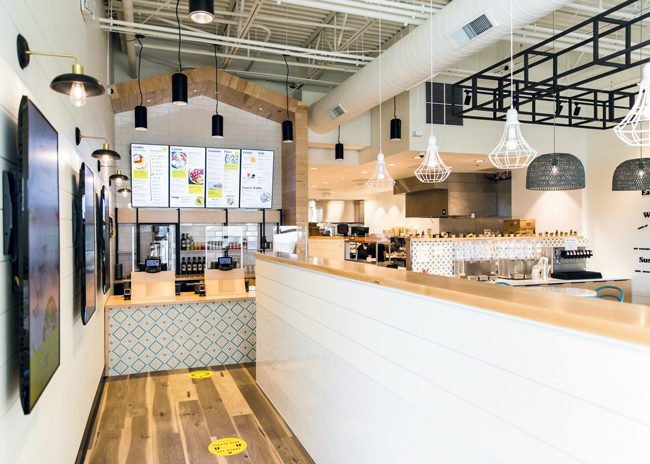 Electronic menu boards allow the chain to easily feature specials with seasonal ingredients.
Electronic menu boards allow the chain to easily feature specials with seasonal ingredients.
At a Glance
- Key players: Rob McColgan, CEO and co-founder; and Anthony Pigliacampo, co-founder
- Interior designer: Amy Pigliacampo
- Chain headquarters: Denver
- Year founded: 2009
- Signature menu items: Fresh salads, grain bowls, toasted sandwiches and brick-oven pizzas
- Number of units: 29
- Unit size: 2,300-2,800 sq. ft.
- Seats per unit: 65-70
- Location type: In-line and endcap
- Average gross sales: $2.3 million
- Check average: $16-$20
The Island Line
Not surprisingly, much of this work has been in the kitchen.
According to Nate Weir, the chain’s vice president of culinary and an 11-year veteran of the company, the first major shift came a few years ago. That’s when the kitchen moved away from a design that had multiple stations operating more or less independently, then sending food to the expo station.
While many concepts utilize this model, for Modern Market, it came about by circumstance more than choice. When the chain started, its menu featured salads and flatbread-style pizzas. Over the years, it added more categories, including sandwiches, soups, plates and bowls, each with its own initiation point.
“It put us in the position where our expo station was incredibly challenging. You are fielding all the incoming fire from all over the restaurant,” Weir says. “All of a sudden, you could have 12 salads backed up while you’re waiting for the next sandwich to come off that station. Our managers, our most competent employees, would end up stuck doing expo because they had the skill set to manage it. That is the first thing we were solving for.”
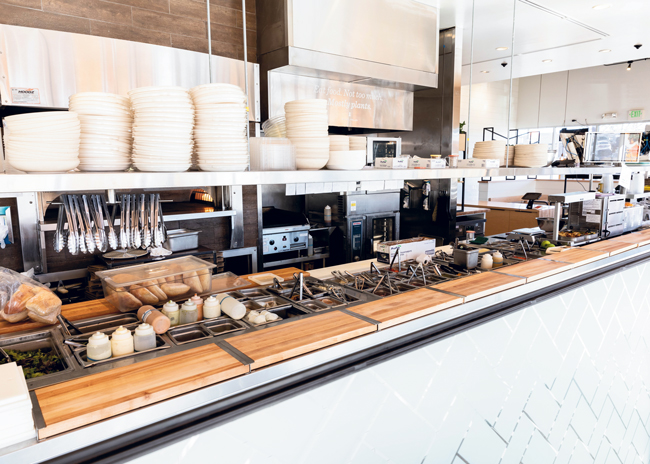 The solution was to move from independent stations to a straight line. With the exception of pizza, practically everything on the menu starts at the beginning of this line. This change, says Weir, has “completely changed the dynamic of our line. We are able to be more efficient and work with fewer bodies.”
The solution was to move from independent stations to a straight line. With the exception of pizza, practically everything on the menu starts at the beginning of this line. This change, says Weir, has “completely changed the dynamic of our line. We are able to be more efficient and work with fewer bodies.”
This single straight-line concept evolved further in 2020, when it went from a single-sided line to a double. Like in previous versions of the restaurant’s setup, this line is visible to the front of the house. Now, though, it is basically a 30-foot-long island with kitchen staffers assembling food on both sides.
This island, it should be stressed, is not composed of two mirrored lines with identical equipment and ingredients on both sides. Instead, staffers on both sides share the same hot and cold wells (along with other equipment) to assemble dishes. “Because they are just open-top, flat coolers, you are able to grab the exact same toppings. All of the actual restocking and stuff like that happens on the primary side of the line that faces into the back of the house,” Weir says.
With this setup, the chain has eliminated issues like the same ingredient being held in wells at multiple stations. It also allows for dedicated lines for in-store and online orders. Modern Market’s kitchen display system simply routes tickets to the appropriate side of the line.
The benefits of this approach don’t stop there. According to Weir, the design lets restaurants create an assembly line for large catering orders, such as boxed lunches, and even presents the opportunity for drive-thru restaurants. “You don’t see a lot of fast casuals with drive-thrus,” he says. “We know we may need to pare the menu down or even take pizzas off the menu, but in theory, you could use that exact same line to service a drive-thru window using the same technology and the same exact flow.”
The line itself starts with what the team jokingly calls the “Inception Station” (inspired by the movie). The first piece of equipment is a rice cooker, which cooks grains for Modern Market’s bowls.
Following the rice cooker is a smart toaster used for toasting ciabatta rolls for sandwiches. The toaster, says Weir, has features like variable speeds as well as an in-and-out feature for gluten-free bread. Paired with the toaster is a bread-warming drawer that can hold 15 toasted ciabattas. That piece is not used during off-peak times. Instead, it’s filled ahead of the lunch and dinner rushes, giving staffers a head start preparing orders.
The final part of the inception station are cold wells, which hold various greens, including romaine, arugula, kale and mixed greens.
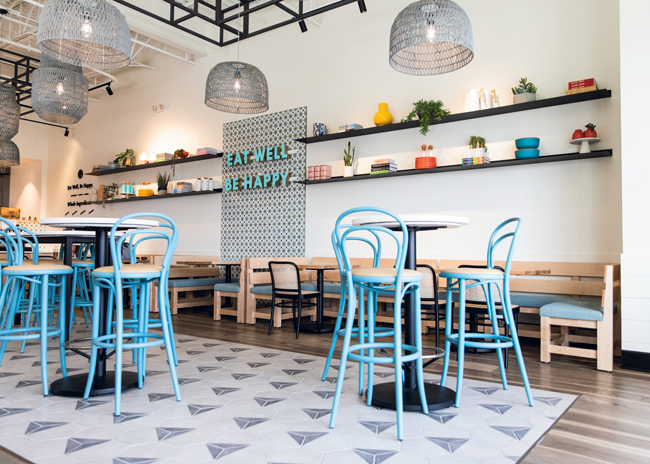 Modern Market’s interior features natural materials like wood, tile and glass.
Modern Market’s interior features natural materials like wood, tile and glass.
When an order comes in, the kitchen display system routes it to the on- or off-premises side and then prints up each menu item in the order on a sticky ticket, says Weir. The ticket can be placed on the outside of the customer’s plate, bowl or sandwich wrapper and is then used by staff to assemble the dish.
“You simply pull the ticket — if it says a sandwich, you get it started and pass it down the line,” Weir adds. “The next one is a salad — you get it started and pass it down the line. The people who are doing the passing and doing the building simply reference that sticky ticket that has the information. It has modifiers listed on there. They are not constantly looking up at a screen. They’re grabbing what is next to them.”
After the Inception Station comes a variety of hot and cold wells that hold the bulk of the restaurant’s ingredients. These include produce, cheeses, dressings, sauces and more.
The island ends with the carving station. This, says Weir, is an important point of distinction for the chain. While many competitors scoop proteins out of wells, Modern Market cuts chicken breast, steak and other items fresh for each individual order in full view of the guests.
Supporting this station is a newer piece of equipment, a countertop warming unit that can hold a full flank steak and four to five chicken breasts at a time. These items, says Weir, were previously held in the restaurant’s combi oven. While effective at keeping temperature, the frequent opening and closing caused the unit to lose too much moisture. Now staff restock the countertop unit in batches from the combi, so moisture loss is no longer an issue.
Another change (this one is in its experimental phase) involves pizza production. The pizza ingredients are stored in a dedicated cold table apart from the island line. Over the years, Modern Market has tried various pizza ovens, including a high-end deck oven and a rotating deck oven. It is now working with a fast-cooking ventless pizza oven that utilizes a push button control panel. Weir’s initial take on the unit is positive. It produces a high-quality product while freeing up staff to walk away from the unit to handle other tasks without the risk of overcooking the pizza.
“I was really interested in it for the cooking speed, the cost and the ability to have three or four for redundancy. It turns out our teams love it because it beeps when the pizza is done,” says Weir.
Aside from the pizza oven and combi oven — a double stack for redundancy and flexibility — the only other piece of hot equipment in the restaurant is a 24-inch flattop. Culinary staff also use this unit to sear meats when they come out of the combi, adding some color to the food and drama to the environment.
In addition to this food assembly equipment, the chain has a small prep area in the back of the house, generally out of guests’ view. The combi oven usually resides here, as do work surfaces, smallwares and countertop equipment like food processors.
Staff primarily handle prep work in the morning, with some additional work taking place throughout the day. The restaurant receives three to four deliveries of fresh produce and protein a week, so it doesn’t need too much refrigeration. The restaurant’s only freezer, meanwhile, holds boxes of ciabatta rolls made by Modern Market’s long-time bakery partner.
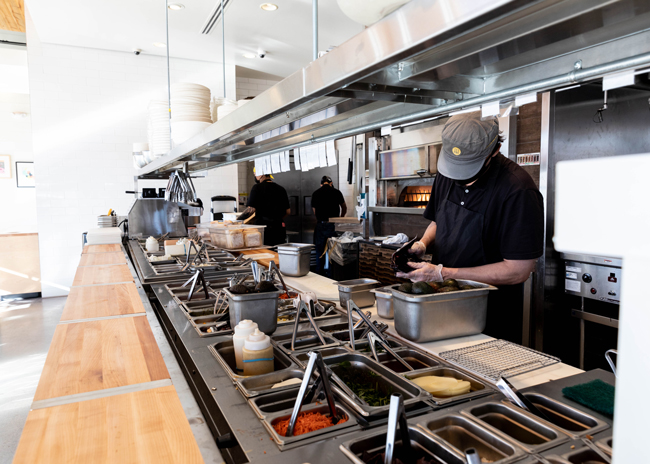 The chain’s island line allows two separate production lines to operate from the same equipment.
The chain’s island line allows two separate production lines to operate from the same equipment.
Interior Adjustments
While Modern Market’s kitchen has changed substantially in recent years, the interior design has been more stable.
According to McColgan, Modern Market’s design is meant to be warm and inviting. Elements feature natural materials like real wood tables, tile-patterned designs on the floors and walls, and artifacts like pottery and succulent plants. Signature colors include light wood tones and a light, almost powder, blue.
While these elements have shifted a bit, says McColgan, the bigger changes are in the front-of-the-house layout. With the rise of internet orders and third-party delivery, the chain is currently testing new locations for some front-of-the-house elements. The goal, he says, is to create a better experience for both dine-in and off-premises customers.
“For instance, if you keep your drink station and condiment area right by where the pickup area is, you start to get a lot of congestion,” says McColgan. “If you want to be considerate of the guests eating at the restaurant, it should be well thought out so the people who are picking up their order or any delivery drivers are not getting in the way. The flow of how food moves throughout the restaurant, we feel, could be optimized a little bit better.”
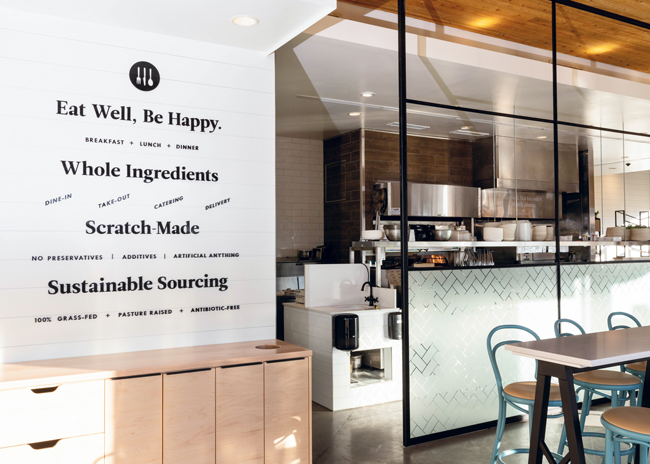
Finding the Right Franchisees
With a new interior and a kitchen that’s designed for the current restaurant environment, Modern Market’s attention has now turned to making its franchise program a success.
According to McColgan, the company’s roughly 30 restaurants operate successfully in a variety of market types, including urban, suburban and heavy residential. The chain is also open to launching in a variety of geographies and is talking to potential franchise partners from all areas of the country.
While Modern Market will obviously teach its business to its franchisees, McColgan hopes the education goes both ways. “We acknowledge we have not franchised before,” he says. “We like to say there is a lot we don’t know. Partnering with a group or individual that has extensive restaurant experience with other brands is really important to us. We want to continue to learn and grow as a partnership evolves. If someone can help us continue to make improvements, that would be a win-win.”
On top of industry experience, the company wants partners who truly buy into the concept. Serving better-for-you food is not as easy as running a standard fast casual. A potential franchisee who’s not ready to invest a little more in equipment, ingredients and training probably isn’t a good fit for Modern Market.
After all, the concept was based
on the idea of providing healthy, high-quality food that someone could eat every day. “Maintaining that identity is key to Modern Market’s success as it begins its franchise journey,” says McColgan. “[We’re looking for partners] that have a real belief, a shared belief in the power of great food and great ingredients and know that sometimes it takes a little bit more complexity in your operations to deliver amazing food.”



